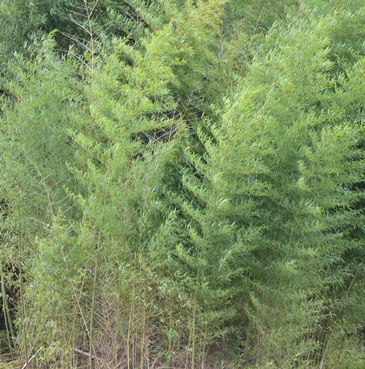Bamboo, the tallest grass in north Florida, can be an attractive landscape specimen or an invasive nightmare. There are more than 700 species of bamboo worldwide, ranging in height from 12 inches to 100 feet or more in ideal growing conditions.
In the U.S., only two species occur naturally (Arundinaria gigantea and A. tecta). Neither of these two plants are used for human food, but other bamboos are a dietary staple or flavoring condiments in Asia and Africa.
Bamboo holds two impressive records in the plant kingdom. It is the largest perennial grass on the planet and it can be the fasted growing plant under the perfect environment.
It has been deliberately propagated and used as an ornamental plant for many years in Florida. The wide variety of colors and textures combined with the exotic shaped and delicate leaves add to the landscaping appeal.
Generally speaking, the two native bamboos are not extremely weedy and are relatively easy to manage. However, there are scores of imported bamboos which are highly invasive and exceedingly difficult to contain in a limited area.
The most common invasive bamboo (Phyllostachys aurea) is commonly known as fishing pole or golden bamboo. It was imported into this country in the 1880’s as an ornamental, being popular as a cold-hearty and quick growing privacy screen.
Because of its weight and relative strength it became an inexpensive and popular source of fishing poles. Curiously, expensive bamboo fly fishing rods are usually made from a less common, but stronger bamboo species native to China.
This and other invasive bamboo varieties have large and complex underground root systems called rhizomes. These shallow roots maintain the plant’s viability by storing and distributing large volumes of nutrients.
Once an invasive bamboo is established the root system supports rapid growth and expansion. Other plants are quickly overwhelms and pushed out.
To control these invasive varieties, the entire rhizome network must be killed. This makes control of bamboo expensive, intensive, time consuming and difficult.
Being a grass bamboo easily tolerates occasional pruning, but regular and intensive mowing is much more effective for destroying this plant. The mowing frequency is similar to a home lawn if success is to be achieved.
The removal of the plant’s above-ground portion is required to deplete the rhizomes and exhaust it. One to two seasons of rigorous mowing is needed before control is achieved.
To learn more about invasive bamboo, contact your local UF/IFAS Extension Office or read IFAS Publication WG 209: Integrated Management of Nonnative Plants in Natural Areas of Florida at http://edis.ifas.ufl.edu/wg209.
- Pokeweed: Adding Purple to the Fall Palet - September 27, 2019
- Wakulla Springs Offers The Biggest, And The Best, Natural Florida Experience - January 4, 2019
- Silent Night It Is Not!!! Cicadas Sing the Evening Away. - October 26, 2018

